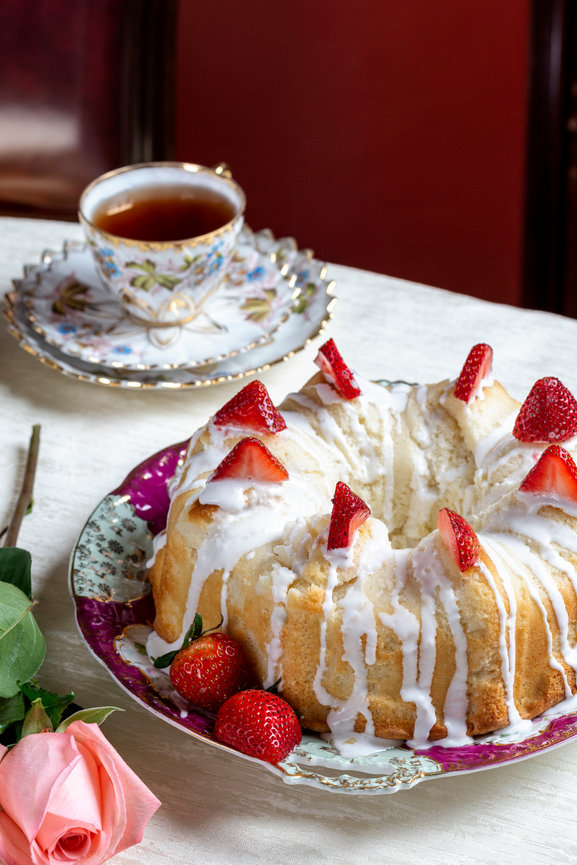Simple, light and elegant, sponge cake was the quintessential cake of the Victorian era, transformed into endless style and flavor combinations. Some were served plain, garnished simply with fruit, whipped cream or a sprinkling of confectioner’s sugar. Others took it up a notch by adding flavorings such as lemon or orange. The most elegant were delicate, two-layer cakes with a jam or cream filling and perhaps some icing drizzled on top.
Cookbooks from the latter part of the nineteenth century contain pages of sponge cake recipes - Almond Sponge Cake, Hot Water Sponge Cake, Cream Sponge Cake, even Perfection Sponge Cake, which called for a whopping fourteen eggs. Then there were the many recipes that used sponge cake as a base, such as Boston Cream Pie, Charlotte Russe (individual dishes lined with sponge cake and topped with whipped cream), Strawberry Short Cake, and the luscious Victoria Sponge. This cake sandwiched Chantilly cream and jam between two fluffy golden cake layers. A favorite of Queen Victoria, it was supposedly introduced by the Duchess of Bedford (one of her ladies-in-waiting and the originator of afternoon tea) in the 1880s and quickly became a huge hit.
In the early part of the 19th century (before chemical leavenings such as baking powder and cream of tartar came on the scene), a sponge cake’s light, airy texture was achieved by beating eggs and sugar for a long time until they were thick, smooth and pale yellow. This “mechanical leavening” whipped air into the eggs to produce a mass of bubbles called a foam, allowing the cake to rise up nice and light due to the expansion of the air bubbles during baking. It was a long and tedious process that sometimes took hours - a task often delegated to servants.
But the Victorian age introduced many kitchen conveniences, including the invention of the rotary eggbeater around 1870 and chemical rising agents such as saleratus (an early form of baking soda), baking soda and baking powder. These newfangled gadgets and ingredients made the cook’s job easier, although many still preferred using eggs as a rising agent. In the words of cookbook author Belle De Graf, “a true sponge cake contains no baking powder but is lightened entirely by the air which has been beaten into the eggs.”
The following version is adapted from Lydia Morris's cookbook. Lydia and her brother John founded the beautiful site now known as the Morris Arboretum, located just outside Philadelphia. In her cookbook, Lydia attributes the source of the recipe to her Aunt Martha.
Here's the original:
Martha Morris’ Recipe for Sponge Cake
10 eggs, the weight of all in sugar, 5 flour, the juice & rind of 1 lemon. The sugar & flour to be mixed together. To be baked in a tolerably quick oven about 3⁄4 of an hour.
Here is my adapted version:
Sponge Cake
- Grated peel and juice from one lemon*
- 2 ½ cups granulated sugar
- 10 eggs, separated
- Pinch of salt
- 3 1/3 cups sifted flour
- Bring all ingredients to room temperature.
- Remove top rack of oven and preheat to 325°F.
- Grate lemon peel into sugar
- Beat egg yolks slightly, then add sugar and lemon juice.
- Beat egg whites and pinch of salt until stiff; fold into yolk mixture.
- Add flour a little at a time, folding in gently. Pour batter into ungreased 10-inch tube pan. Bake at 325°F for one hour.
- Remove from oven and stand cake upside down on the neck of a bottle until completely cooled.
*For a more subtle lemon flavor, reduce lemon juice to 1 tsp.
Taste this and other delectable tea-time treats adapted from Lydia's cookbook (including tea cakes, jumbles and Washington Cake) and learn all about the origins and social protocol of afternoon tea this Sunday. April 28 at the Morris Arboretum from 1-3 pm!






0 Comments